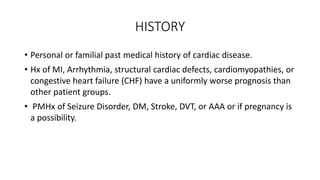This document provides an overview of syncope by Dr. Mohammed Lukman Abolaji. It defines syncope and discusses the pathophysiology, including how a loss of cerebral blood flow can cause loss of consciousness. It outlines the most common causes or etiologies of syncope including reflex or neurally mediated syncope, orthostatic hypotension, and cardiac syncope. It emphasizes that obtaining a thorough history and physical examination is important for evaluating syncope and determining its underlying cause in 50-85% of patients.


































![REFERENCES
• Walsh K, Hoffmayer K, Hamdan MH. Syncope: diagnosis and management.
Curr Probl Cardiol. 2015 Feb. 40 (2):51-86. [Medline].
• [Guideline] Huff JS, Decker WW, Quinn JV, et al. Clinical policy: critical
issues in the evaluation and management of adult patients presenting to
the emergency department with syncope. Ann Emerg Med. 2007 Apr.
49(4):431-44. [Medline]. [Full Text].
• Moya A, Sutton R, Ammirati F, et al. Guidelines for the diagnosis and
management of syncope (version 2009): the Task Force for the Diagnosis
and Management of Syncope of the European Society of Cardiology (ESC).
Eur Heart J. 2009 Nov. 30(21):2631-71. [Medline].](https://image.slidesharecdn.com/syncope-210728135440/85/Syncope-35-320.jpg)
![REFERENCES
• Tretter JT, Kavey RE. Distinguishing cardiac syncope from vasovagal
syncope in a referral population. J Pediatr. 2013 Dec. 163(6):1618-
1623. [Medline].
• Chen L, Chen MH, Larson MG, Evans J, Benjamin EJ, Levy D. Risk
factors for syncope in a community-based sample (the Framingham
Heart Study). Am J Cardiol. 2000 May 15. 85(10):1189-93. [Medline].](https://image.slidesharecdn.com/syncope-210728135440/85/Syncope-36-320.jpg)